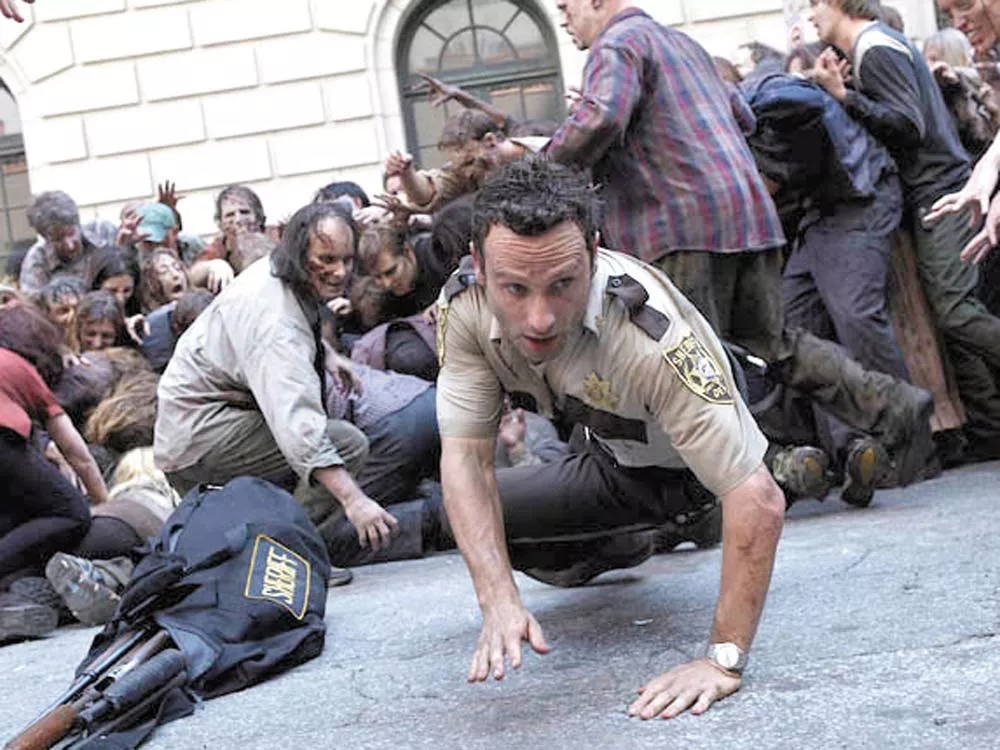Television is crammed with bombastic music, packed with witty dialogue. Rarely is it quiet. Music and dialogue create distance. Music turns the action on screen into a ballet; dialogue turns it into a radio play.
But silence ... silence is the cinematic equivalent of holding your breath. It demands you focus purely on the visual. It locks you onto the screen and draws you in, deeply.
Silence is the great tool of Walking Dead, television’s foray into the zombie apocalypse genre. Zombie tales are metaphors — about consumerism, mundane routine and the inherent inhumanity of humanity.
In Walking Dead’s first episode, however, it’s a tale about loneliness. Rick Grimes (Andrew Lincoln) is a sheriff’s deputy who wakes up from his gunshot-wound coma to find an empty hospital. His world has been transformed into a hellscape filled with shambling undead. (Grimes’ wounded limp, fittingly, parallels the zombies’ stumbling gait.)
There’s where the silence comes in. This is a world without the hum of traffic or chattering of crowds. There’s only a sporadic creak of metal, a snapping of twigs, a hiss of wind, a gunshot’s ring and, naturally, the ever-present moaning of the undead.
And Grimes doesn’t talk much. He’s not Ash from Evil Dead. No bad-ass one-liners.
Comic books are an entirely visual medium. And Walking Dead, based on a comic book series, feeds us a stream of iconic images. Director Frank Darabont (The Shawshank Redemption) gives us unforgettable views of rotten fingers clawing through a crack in a hospital door, two survivors smeared with zombie gore slipping through the horde and the horrified gaze of a man staring at his infected wife through a sniper scope — as she, with her fragments of remaining memories, mouths “I love you.” This, against sparse emptiness and despair.
But Walking Dead loses its power when the dialogue begins. The characters aren’t exaggerated enough to be fun or multi-layered enough to be human. The lines aren’t cheesy enough to be camp or nuanced enough to be real. The actors are great at delivering silent anguished reactions, less so at delivering grim exposition.
Images are, in the end, Walking Dead’s strength. Words are its weakness.
The Walking Dead (AMC, Sundays, 10 pm)
TIVO-WORTHY
Sym-Bionic Titan
Add “Degrassi meets Mecha-Godzilla” to the list of combinations you don’t expect to see on television. Shape-shifting robot aliens Lance, Ilana, and Octus disguise themselves as archetypal Earthling high school students to escape the wrathful gaze of evil General Mondula. Sym-Bionic Titan sports the gorgeous animation of Genndy Tartakovsky, the visionary behind Samurai Jack and Star Wars: Clone Wars.
“But can all the robots combine together into a gargantuan CGI robot when comes time to do battle against a city-sized monster?” the cautious media consumer wants to know. Of course they can. (Cartoon Network, Fridays, 8 pm)
Human Target
The one television show to capture the fist-throwing escapist fun of the Indiana Jones series, Human Target, is finally back. The new showrunner, Chuck veteran Matt Miller, has added two gorgeous female characters to the team (hooray!) and swapped out Bear McCreary’s grand action-movie orchestral soundtrack to fit in more contemporary pop songs (what the hell are you thinking!?). (Fox, Wednesdays, 8 pm)
Meteorite Men
Two men search for space rocks that, lamely, will give them no superpowers whatsoever. (Science Channel, Tuesdays, 9 pm)

